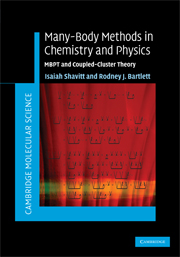Book contents
- Frontmatter
- Contents
- Preface
- 1 Introduction
- 2 Formal perturbation theory
- 3 Second quantization
- 4 Diagrammatic notation
- 5 Diagrammatic expansions for perturbation theory
- 6 Proof of the linked-diagram theorem
- 7 Computational aspects of MBPT
- 8 Open-shell and quasidegenerate perturbation theory
- 9 Foundations of coupled-cluster theory
- 10 Systematic derivation of the coupled-cluster equations
- 11 Calculation of properties in coupled-cluster theory
- 12 Additional aspects of coupled-cluster theory
- 13 The equation-of-motion coupled-cluster method for excited, ionized and electron-attached states
- 14 Multireference coupled-cluster methods
- References
- Author index
- Subject index
14 - Multireference coupled-cluster methods
Published online by Cambridge University Press: 06 January 2010
- Frontmatter
- Contents
- Preface
- 1 Introduction
- 2 Formal perturbation theory
- 3 Second quantization
- 4 Diagrammatic notation
- 5 Diagrammatic expansions for perturbation theory
- 6 Proof of the linked-diagram theorem
- 7 Computational aspects of MBPT
- 8 Open-shell and quasidegenerate perturbation theory
- 9 Foundations of coupled-cluster theory
- 10 Systematic derivation of the coupled-cluster equations
- 11 Calculation of properties in coupled-cluster theory
- 12 Additional aspects of coupled-cluster theory
- 13 The equation-of-motion coupled-cluster method for excited, ionized and electron-attached states
- 14 Multireference coupled-cluster methods
- References
- Author index
- Subject index
Summary
Introduction
As in the case of quasidegenerate perturbation theory (Chapter 8), multireference coupled-cluster (MRCC) theory is designed to deal with electronic states for which a zero-order description in terms of a single Slater determinant does not provide an adequate starting point for calculating the electron correlation effects. As already discussed in Chapters 8 and 13, these situations arise primarily for certain open-shell systems that are not adequately described by a high-spin single determinant (such as transitionmetal atoms), for excited states in general and for studies of bond breaking on potential-energy surfaces; they arise usually because of the degeneracy or quasidegeneracy of the reference determinants. While single-reference coupled-cluster (SRCC) methods are very effective in treating dynamic electron correlation, the conditions discussed here involve nondynamic correlation effects that are not described well by truncated SRCC at practical levels of treatment.
As shown in Section 13.4, many open-shell and multireference states can be treated by EOM-CC methods, including a single excitation from a closed shell state to an open-shell singlet state, which normally requires two equally weighted determinants in its zero-order description. Furthermore, doubleionization and double-electron-attachment EOM-CC, as well as spin-flip CC (Krylov 2001), allow the treatment of many inherently multireference target states. These methods have the advantage of being operationally of single-reference form, since then the only choices that need to be made are of the basis set and the level of correlation treatment. Although, they require an SRCC solution for an initial state (not necessarily the ground state) to initiate the procedure, once initiated multireference target states are available by the diagonalization of an effective Hamiltonian matrix in a determinantal representation.
Information
- Type
- Chapter
- Information
- Many-Body Methods in Chemistry and PhysicsMBPT and Coupled-Cluster Theory, pp. 462 - 495Publisher: Cambridge University PressPrint publication year: 2009
Accessibility standard: Unknown
Why this information is here
This section outlines the accessibility features of this content - including support for screen readers, full keyboard navigation and high-contrast display options. This may not be relevant for you.Accessibility Information
- 1
- Cited by
